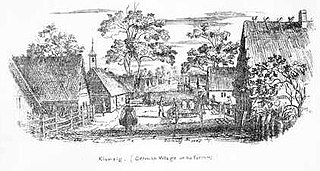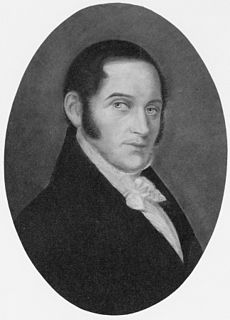Related Research Articles

Hahndorf is a small town in the Adelaide Hills region of South Australia. Currently an important tourism spot, it has previously been a centre for farming and services.

Gotthard Daniel Fritzsche was a Prussian-Australian pastor who became instrumental in furthering that religion in South Australia. He was born in Liebenwerda, in the Electorate of Saxony, Germany, and migrated to Australia in 1841. From 1842–1863, he was pastor of the Evangelical Lutheran Church. He died and was buried at Lobethal, South Australia.

August Ludwig Christian Kavel. Pastor Kavel was a founder of Lutheranism in Australia.
Prince George was launched in 1828 at Newcastle upon Tyne. She was an East Indiaman, initially sailing under a license from the British East India Company (EIC). She made two voyages to South Australia, carrying 200 Prussian immigrants on the first. She was wrecked in July 1841 near Hong Kong.
Bengalee was a three-masted merchant barque built in 1837 at Dumbarton. She first appeared in Lloyd's Register (LR) in 1838 with Hamlin, master, Hamlin and Company, of Greenock, owners, and trade Clyde–Calcutta. Captain Thomas Hamlin did not allow the consumption of alcohol on his ship, thus it was known as a temperance ship.
The Catharina was a barque, built 1810 in Kiel, and weighing 350 tons.
The Skjold was a Danish three mast Barque, built in Sønderborg 1839, and displacing 460 tons. It was owned by C. Petersen, Sønderborg.

German settlement in Australia began in large numbers in 1838, with the arrival of immigrants from Prussia to Adelaide, in the then colony of South Australia. German immigrants became prominent in settling South Australia and the Queensland. From 1850 until World War I, German settlers and their descendants comprised the largest non-British or Irish group of Europeans in Australia.

Captain Dirk Meinerts Hahn, sometimes spelt Dirk Meinertz Hahn was probably best known as the captain of the ship Zebra that he captained to South Australia where the town of Hahndorf was named after him. A monument dedicated to him in Hahndorf was unveiled in 1939.
Duke of Roxburgh was launched in 1828 at Newcastle upon Tyne. Initially she traded with India, but later she often sailed between Great Britain and her Australasian colonies carrying emigrants. She was wrecked in 1864.

Klemzig is a suburb of Adelaide in the City of Port Adelaide Enfield. It was the first settlement of German immigrants in Australia and was named after the village of Klemzig, near Züllichau in southeastern Brandenburg in the German state of Prussia, where they originated from. That Klemzig is now in western Poland and is now known by the Polish name Klępsk.
Lady Mary Pelham was a brig launched in 1816 that initially worked as a Falmouth packet. After her modification to a barque she became part of the South Australia Company's fleet of 1836. She later served as a whaler and transport between Van Diemen's Land and Portland, Victoria. She was wrecked in 1849.
John Barry was a three-masted merchant ship, convict transport, and immigrant transport built in 1814 at Whitby, England by John Barry for his own interests. A typhoon damaged her in 1841 and at last report she was an opium hulk at Hong Kong.
Roslin Castle was a barque of 450 tons built in 1819 at Bristol. She was a merchant ship that also made five voyages transporting convicts to Australia. Described as a single decker, her hull was sheathed in copper in 1823 and was sheathed in patent felt and copper over-boards in 1828. She later served as a whaling vessel out of Sydney, Australia.
Coromandel was 662 tons burthen (bm), sailing ship built at Quebec in 1834. She was owned by Ridgeway and her home port was Glasgow. She was the first ship to bring settlers to South Australia after it was proclaimed a colony in 1836 and one of the early ships bringing New Zealand Company settlers to Wellington, New Zealand in 1840.
Katherine Stewart Forbes was a barque built at Northfleet docks in Kent in 1818 to "second description first class" for the Chapman company and was variously recorded as a ship and a barque. She initially sailed between Britain and India under a license from the British East India Company (EIC). She next transported convicts to Australia in 1830 and 1832. She also carried early settlers to South Australia in 1837, and New Zealand in 1841 and 1851, and mapped part of the coast of Borneo.

Traugott Wilhelm Boehm was a schoolmaster, founder of the German School in Hahndorf, South Australia, which became Hahndorf Academy then Hahndorf College.
David Clark was launched in 1816 and may have been broken up at Batavia in 1854. She sailed one of the last voyages under charter to the British East India Company (EIC). In 1839 she carried mainly Scots assisted migrants to Australia, and was the first immigrant ship to sail from the Great Britain directly to Port Phillip. In 1842 she transported more than 300 convicts to Hobart. She was last listed in Lloyd's Register in 1854.
Elizabeth was a merchant ship built at Dartmouth, England in 1805. She made one voyage transporting convicts from England to Australia. She was condemned in 1838.
Thomas Harrison was a barque, used to transport free settlers and convicts from Ireland and England to Australia and New Zealand from 1835 to 1842.
References
- "Ships arriving in South Australia 1838", Pioneers Association of South Australia
- "Shipping Arrivals", South Australian Genealogy & Heraldry Society Inc
- "Prince George", Private homepage of Graeme Moad
- "Captain Dirk Hahn and the "Hahndorf" passengers to South Australia", German Australia, David Nutting
- "Zebra 1839", Private webpages of DIANE CUMMINGS
- "Passenger List Zebra 1839"